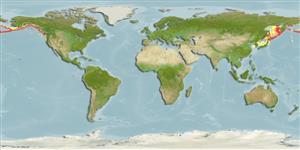Issue
Careproctus cryptacanthoides Krasyukova, 1984, Careproctus entomelas Gilbert & Burke, 1912, and Careproctus entargyreus Gilbert & Burke, 1912 may be junior synonyms of this species. Currently treated as valid in the annotated checklist (Ref. 51661).
Environment: milieu / climate zone / depth range / distribution range
Ecology
Marine; bathydemersal; depth range 64 - 1350 m (Ref. 43939), usually 400 - 600 m (Ref. 56456). Deep-water
North Pacific: Sea of Japan and Sea of Okhotsk to the Gulf of Alaska.
Size / Weight / Age
Maturity: Lm ? range ? - ? cm
Max length : 44.0 cm TL male/unsexed; (Ref. 56456); common length : 27.0 cm TL male/unsexed; (Ref. 56456); max. published weight: 1.2 kg (Ref. 56456); max. reported age: 6 years (Ref. 56456)
Short description
Morphology | Morphometrics
Dorsal
spines
(total): 0;
Dorsal
soft rays
(total): 51-58;
Anal
spines: 0;
Anal
soft rays: 47 - 52;
Vertebrae: 59 - 65. Teeth lanceolate; outer teeth about equal to inner teeth in length; length of lower pectoral fin lobe contained 0.8 to 1.2 times in head length; disk length 15.0 to 27.6% of head length (Ref. 559). Body reddish black; vertical fins black; peritoneum black; stomach pale (Ref. 559).
Found on mud and sand bottoms (Ref. 43939).
Life cycle and mating behavior
Maturity | Reproduction | Spawning | Eggs | Fecundity | Larvae
Mecklenburg, C.W., T.A. Mecklenburg and L.K. Thorsteinson, 2002. Fishes of Alaska. American Fisheries Society, Bethesda, Maryland. xxxvii +1037 p. (Ref. 43939)
IUCN Red List Status (Ref. 130435)
Threat to humans
Harmless
Human uses
Fisheries: of no interest
More information
Common namesSynonymsMetabolismPredatorsEcotoxicologyReproductionMaturitySpawningSpawning aggregationFecundityEggsEgg development
ReferencesAquacultureAquaculture profileStrainsGeneticsElectrophoresesHeritabilityDiseasesProcessingNutrientsMass conversion
Tools
Special reports
Download XML
Internet sources
Estimates based on models
Preferred temperature (Ref.
123201): 1.5 - 4.2, mean 2.3 °C (based on 85 cells).
Phylogenetic diversity index (Ref.
82804): PD
50 = 0.5000 [Uniqueness, from 0.5 = low to 2.0 = high].
Bayesian length-weight: a=0.00417 (0.00262 - 0.00664), b=3.28 (3.14 - 3.42), in cm total length, based on LWR estimates for this species & Genus-body shape (Ref.
93245).
Trophic level (Ref.
69278): 3.3 ±0.61 se; based on food items.
Resilience (Ref.
120179): Medium, minimum population doubling time 1.4 - 4.4 years (Preliminary K or Fecundity.).
Fishing Vulnerability (Ref.
59153): Low to moderate vulnerability (34 of 100).
